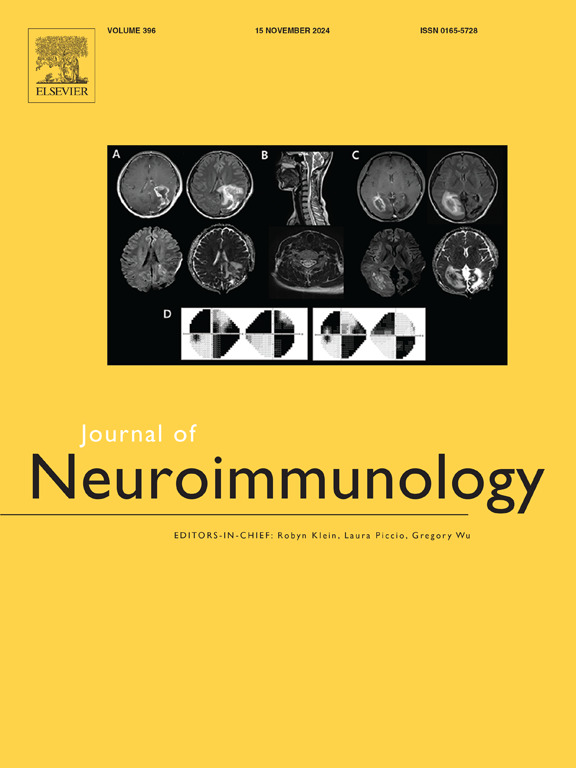Clinical characteristics and immunotherapy efficacy in autoimmune-associated benign epilepsy with centrotemporal spikes: A prospective cohort study
IF 2.5
4区 医学
Q3 IMMUNOLOGY
引用次数: 0
Abstract
Introduction
Benign Epilepsy with Centrotemporal Spikes (BECTS) is the most common form of focal epilepsy in pediatric patients. In clinical practice, immune dysregulation and neuroinflammation have been observed in a subset of patients with BECTS harboring latent Herpesviridae infections, including the Epstein-Barr Virus (EBV) and Human Cytomegalovirus (CMV). Therefore, the present study aimed to explore the correlation between clinical characteristics and immune dysregulation in autoimmunity-associated BECTS and latent viral or Mycoplasma infections.
Method
Fourteen pediatric patients diagnosed with autoimmunity-associated BECTS were prospectively enrolled and underwent assessment of their presentations and etiological and immunological indicators. Further, we evaluated the effectiveness and safety of specific immune therapies (intravenous methylprednisolone and/or intravenous immunoglobulin). Therapy efficacy was determined by a reduction in Rolandic spikes on electroencephalogram recordings and seizure frequency. Potential risk factors were assessed through a retrospective comparative analysis with a control group comprising 46 patients diagnosed with cryptogenic BECTS.
Result
The autoimmunity-associated BECTS cohort demonstrated a higher likelihood of cognitive impairment, ADHD, psychiatric symptoms, and atypical BECTS; required a greater number of anti-seizure medications (ASMs); and experienced longer delays from symptom onset to hospital admission. The prevalence of CMV infection was also found to be significantly higher in the autoimmune disease group than in the control group. Elevated levels of IL-6, IgG, and Complement C3 were observed in the sera of both infected and non-infected children with BECTS. Atypical BECTS and Bilateral Rolandic spikes in EEG were identified as key risk factors for autoimmunity-associated BECTS. Following immunotherapy (intravenous methylprednisolone and/or intravenous immunoglobulin), a substantial reduction in seizure frequency and accumulated spike-wave index (AccSWI) was observed.
Conclusion
These findings support the hypothesis that autoimmune mechanisms contribute to the pathogenesis of selected BECTS cases. Latent viral infections such as CMV may serve as potential triggers. Atypical presentations of BECTS, with Bilateral Rolandic spikes in EEG, indicate the possibility of an autoimmune-associated trigger. Immunotherapy appears to offer therapeutic benefits to patients with autoimmunity-associated BECTS.
Clinical trial registration
This single-center, longitudinal observational study (XH-16-029/NCT02969213) included pediatric patients diagnosed with epilepsy.
伴有中央颞叶尖峰的自身免疫相关良性癫痫的临床特征和免疫治疗效果:一项前瞻性队列研究
良性癫痫伴中央颞叶尖峰(BECTS)是小儿局灶性癫痫最常见的形式。在临床实践中,在一部分潜伏疱疹病毒感染的BECTS患者中观察到免疫失调和神经炎症,包括eb病毒和人巨细胞病毒(CMV)。因此,本研究旨在探讨自身免疫相关BECTS和潜伏病毒或支原体感染的临床特征与免疫失调之间的相关性。方法前瞻性纳入14例诊断为自身免疫相关BECTS的儿童患者,并对其表现、病因学和免疫学指标进行评估。此外,我们评估了特异性免疫疗法(静脉注射甲基强的松龙和/或静脉注射免疫球蛋白)的有效性和安全性。治疗效果是由脑电图记录的罗兰迪峰和癫痫发作频率的减少来确定的。通过与46名诊断为隐源性BECTS的患者组成的对照组进行回顾性比较分析,评估潜在的危险因素。结果与自身免疫相关的BECTS队列显示认知障碍、ADHD、精神症状和非典型BECTS的可能性更高;需要更多的抗癫痫药物(asm);并且从症状出现到住院的时间延迟更长。自身免疫性疾病组的巨细胞病毒感染率也明显高于对照组。在感染和未感染BECTS的儿童血清中均观察到IL-6、IgG和补体C3水平升高。非典型BECTS和脑电图双侧罗兰峰被确定为自身免疫相关BECTS的关键危险因素。免疫治疗(静脉注射甲基强的松龙和/或静脉注射免疫球蛋白)后,观察到癫痫发作频率和累积峰波指数(AccSWI)显著降低。结论这些发现支持了自身免疫机制参与部分BECTS病例发病机制的假设。潜伏的病毒感染,如巨细胞病毒可能是潜在的触发因素。非典型的BECTS表现,脑电图双侧罗兰峰,提示可能存在自身免疫相关触发。免疫疗法似乎为自身免疫相关BECTS患者提供了治疗益处。临床试验注册:这项单中心纵向观察研究(XH-16-029/NCT02969213)纳入了诊断为癫痫的儿科患者。
本文章由计算机程序翻译,如有差异,请以英文原文为准。
求助全文
约1分钟内获得全文
求助全文
来源期刊

Journal of neuroimmunology
医学-免疫学
CiteScore
6.10
自引率
3.00%
发文量
154
审稿时长
37 days
期刊介绍:
The Journal of Neuroimmunology affords a forum for the publication of works applying immunologic methodology to the furtherance of the neurological sciences. Studies on all branches of the neurosciences, particularly fundamental and applied neurobiology, neurology, neuropathology, neurochemistry, neurovirology, neuroendocrinology, neuromuscular research, neuropharmacology and psychology, which involve either immunologic methodology (e.g. immunocytochemistry) or fundamental immunology (e.g. antibody and lymphocyte assays), are considered for publication.
 求助内容:
求助内容: 应助结果提醒方式:
应助结果提醒方式:


